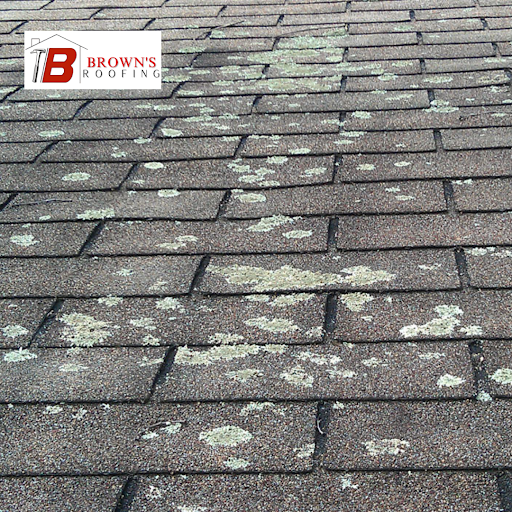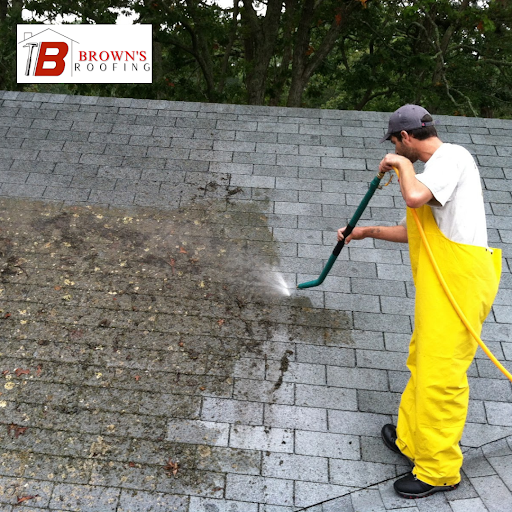If you’ve noticed dark streaks, green patches, or crusty growth on your roof, you’re not alone. Roof stains are common in many climates and can come from several sources—most notably algae, lichen, moss, and environmental debris. Understanding what causes these stains and how to prevent them will help you protect your home’s curb appeal and, more importantly, the lifespan of your roof.
This guide from Browns Roofing explains what’s happening on your shingles, which solutions really work, and how to avoid warranty-voiding mistakes.
What’s Causing Those Dark Streaks? Algae 101
- The most common culprit behind dark roof streaks is a blue-green algae called Gloeocapsa magma.
- It thrives in humid environments, shaded roof sections, and areas where airborne moisture persists.
- Algae feeds on the limestone filler commonly used in many asphalt shingles. As it grows, it leaves pigmented, dark streaks that run down the roof.
Key signs of algae:
- Smoky, dark streaks (often starting on the north- or east-facing slopes)
- More prevalent under trees or where roofs stay damp longer
- Doesn’t wipe away easily—bleaching agents are typically required to remove it
Algae Growth: Conditions That Speed It Up
- Moisture retention: Shade from trees, clogged gutters, and poor ventilation keep shingles damp.
- Nutrient availability: Limestone fillers inside many shingles can become a food source.
- Warm, humid climates: Regions with warm summers and regular rainfall are algae hot spots.
- Airborne spores: Algae spreads by spores carried on wind, animals, and rainfall.
Fact check: Do paper mills and chemical plants nearby accelerate algae growth?
- Available research does not conclusively show that emissions from paper mills or chemical plants directly accelerate Gloeocapsa magma growth on roofs.
- Industrial areas may have higher airborne particulates that could settle on surfaces, potentially trapping moisture or providing surfaces for spores to cling to. However, this is not a well-established or primary driver compared to moisture, shade, climate, and shingle composition.
- Bottom line: The strongest predictors of roof algae are humidity, shade, and the presence of limestone fillers—not proximity to paper or chemical plants.

Lichen and Moss: Different Organisms, Bigger Risks
- Lichen: A symbiotic organism made of algae (or cyanobacteria) and fungi living together. Lichens form flat, crusty, or leafy patches tightly bonded to the shingle surface (often pale green, gray, or yellowish).
- Why it’s a problem: Lichens anchor into the granule layer of asphalt shingles. Their root-like structures (rhizines) and acids can loosen or remove protective granules, accelerating shingle wear, reducing UV protection, and shortening roof life.
- Moss: A small, non-vascular plant that forms thick, spongy mats.
- Why it’s a problem: Moss holds water against the roof, leading to prolonged moisture, freeze–thaw damage, lifted shingles, and potential leaks at overlaps and fasteners.
Signs of lichen and moss damage:
- Granule loss and bald spots
- Shingles lifting or curling at edges
- Persistent dampness and green clumps
Prevention First: Roofing Products Designed to Resist Algae
Modern roofing products offer long-term, low-maintenance solutions:
- Algae-resistant shingles with embedded copper or zinc-containing granules:
- These granules slowly release ions that inhibit algae growth on the roof surface.
- Notable examples:
- Atlas Roofing shingles with Scotchgard Protector: Atlas incorporates copper-containing granules (by 3M) designed to resist algae staining for the life of the shingle under their warranty terms.
- Owens Corning Duration Series (higher-grade shingles): Many Duration lines include algae-resistant technology (often labeled AR), using specialized granules to help prevent algae staining.
- Benefits: Built-in, passive protection that doesn’t depend on homeowner-applied treatments; preserves aesthetics and reduces maintenance.
Tip: When evaluating shingles, look for “AR,” “algae-resistant,” “Scotchgard Protector,” or “StreakFighter”-type branding and review warranty specifics about algae staining coverage.
The “Old School” Solution: Zinc (and Copper) Strips
- How they work: Zinc or copper strips installed near the ridge release ions when it rains; runoff distributes these ions down the roof, inhibiting algae, lichen, and moss.
- Pros: Non-chemical, relatively low cost after installation, can help on existing roofs.
- Cons:
- Effectiveness diminishes farther from the ridge (lower courses may get less protection).
- Aesthetics: Visible metal strip near the ridge.
- Maintenance: Oxidation and installation quality affect longevity and performance.
Verdict: Useful as a supplemental solution, especially for existing roofs. For new or replacement roofs, algae-resistant shingles provide more uniform, built-in protection.
Important Warning: Roof Cleaning Can Void Warranties
- High-pressure washing, harsh chemicals, and improper cleaning methods can damage shingles by stripping protective granules, lifting edges, and degrading sealant strips.
- Many manufacturers explicitly warn that non-approved cleaning methods can void warranties.
- Best practice: Choose the correct roofing material up front—AR shingles with copper- or zinc-containing granules—and follow the manufacturer’s care guidelines. If cleaning is necessary, use a reputable professional who follows manufacturer-approved, low-pressure, soft-wash methods and the appropriate cleaning solutions.
Pro tip from Browns Roofing: Before any cleaning, review your shingle warranty and care instructions and consult with your roofer. The cost of an improper wash can exceed the cost of prevention.

Additional Homeowner Tips to Reduce Roof Staining
- Trim overhanging branches to increase sunlight and airflow; this speeds drying.
- Keep gutters clean so water doesn’t back up onto the roof edge.
- Ensure attic ventilation meets code and manufacturer specs to reduce heat and moisture buildup.
- Avoid allowing leaves and debris to accumulate; organic matter traps moisture and feeds growth.
- Consider installing algae-resistant shingles when replacing your roof; it’s the most durable solution.
What To Do If You Already Have Stains
- Identify the organism:
- Dark streaks that aren’t fuzzy or raised = likely algae.
- Crusty, firmly attached patches = likely lichen.
- Thick, spongy clumps = moss.
- Avoid DIY pressure washing.
- Ask a professional roofer about manufacturer-approved soft-wash options and whether your roof’s condition and warranty allow cleaning—or whether replacement with AR shingles is the better long-term move.
Why Choosing the Right Shingle Matters
- Long-term appearance: Built-in algae resistance keeps your roof looking newer for longer.
- Protection: Preserving granules preserves UV resistance and shingle durability.
- Warranty confidence: Installing compatible, algae-resistant products and following care guidance helps keep warranties intact.
The Browns Roofing Advantage
- Product guidance: We help you compare algae-resistant options from trusted manufacturers like Atlas and Owens Corning Duration higher-grade shingles.
- Proper installation: Correct underlayments, ventilation, and flashing details reduce moisture issues that encourage biological growth.
- Warranty-aligned practices: We follow manufacturer specifications to protect your investment.
Have questions about roof stains, algae-resistant shingles, or the best solution for your home? Contact Browns Roofing to schedule an inspection and get a tailored plan that protects your roof and enhances curb appeal.
